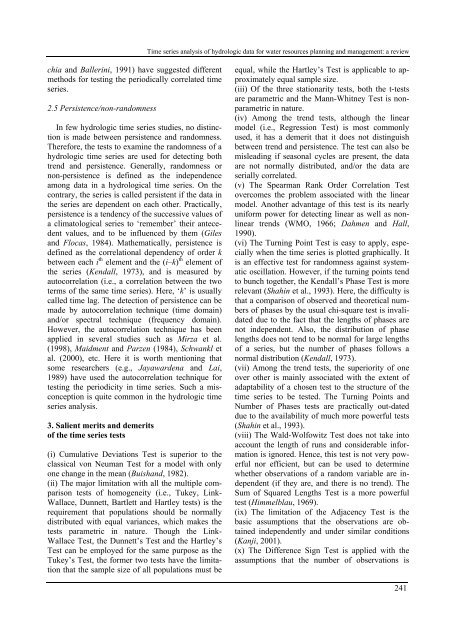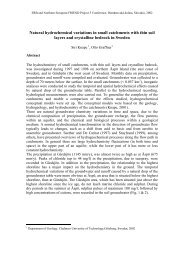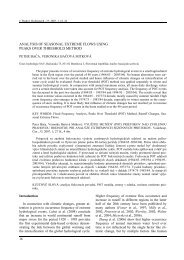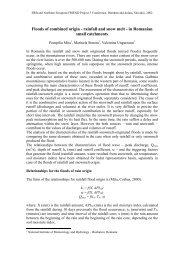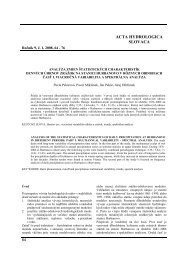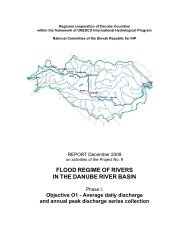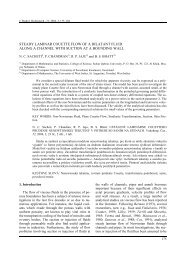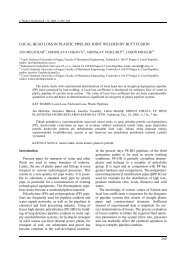TIME SERIES ANALYSIS OF HYDROLOGIC DATA FOR WATER ...
TIME SERIES ANALYSIS OF HYDROLOGIC DATA FOR WATER ...
TIME SERIES ANALYSIS OF HYDROLOGIC DATA FOR WATER ...
Create successful ePaper yourself
Turn your PDF publications into a flip-book with our unique Google optimized e-Paper software.
Time series analysis of hydrologic data for water resources planning and management: a reviewchia and Ballerini, 1991) have suggested differentmethods for testing the periodically correlated timeseries.2.5 Persistence/non-randomnessIn few hydrologic time series studies, no distinctionis made between persistence and randomness.Therefore, the tests to examine the randomness of ahydrologic time series are used for detecting bothtrend and persistence. Generally, randomness ornon-persistence is defined as the independenceamong data in a hydrological time series. On thecontrary, the series is called persistent if the data inthe series are dependent on each other. Practically,persistence is a tendency of the successive values ofa climatological series to ‘remember’ their antecedentvalues, and to be influenced by them (Gilesand Flocas, 1984). Mathematically, persistence isdefined as the correlational dependency of order kbetween each i th element and the (i–k) th element ofthe series (Kendall, 1973), and is measured byautocorrelation (i.e., a correlation between the twoterms of the same time series). Here, ‘k’ is usuallycalled time lag. The detection of persistence can bemade by autocorrelation technique (time domain)and/or spectral technique (frequency domain).However, the autocorrelation technique has beenapplied in several studies such as Mirza et al.(1998), Maidment and Parzen (1984), Schwankl etal. (2000), etc. Here it is worth mentioning thatsome researchers (e.g., Jayawardena and Lai,1989) have used the autocorrelation technique fortesting the periodicity in time series. Such a misconceptionis quite common in the hydrologic timeseries analysis.3. Salient merits and demeritsof the time series tests(i) Cumulative Deviations Test is superior to theclassical von Neuman Test for a model with onlyone change in the mean (Buishand, 1982).(ii) The major limitation with all the multiple comparisontests of homogeneity (i.e., Tukey, Link-Wallace, Dunnett, Bartlett and Hartley tests) is therequirement that populations should be normallydistributed with equal variances, which makes thetests parametric in nature. Though the Link-Wallace Test, the Dunnett’s Test and the Hartley’sTest can be employed for the same purpose as theTukey’s Test, the former two tests have the limitationthat the sample size of all populations must beequal, while the Hartley’s Test is applicable to approximatelyequal sample size.(iii) Of the three stationarity tests, both the t-testsare parametric and the Mann-Whitney Test is nonparametricin nature.(iv) Among the trend tests, although the linearmodel (i.e., Regression Test) is most commonlyused, it has a demerit that it does not distinguishbetween trend and persistence. The test can also bemisleading if seasonal cycles are present, the dataare not normally distributed, and/or the data areserially correlated.(v) The Spearman Rank Order Correlation Testovercomes the problem associated with the linearmodel. Another advantage of this test is its nearlyuniform power for detecting linear as well as nonlineartrends (WMO, 1966; Dahmen and Hall,1990).(vi) The Turning Point Test is easy to apply, especiallywhen the time series is plotted graphically. Itis an effective test for randomness against systematicoscillation. However, if the turning points tendto bunch together, the Kendall’s Phase Test is morerelevant (Shahin et al., 1993). Here, the difficulty isthat a comparison of observed and theoretical numbersof phases by the usual chi-square test is invalidateddue to the fact that the lengths of phases arenot independent. Also, the distribution of phaselengths does not tend to be normal for large lengthsof a series, but the number of phases follows anormal distribution (Kendall, 1973).(vii) Among the trend tests, the superiority of oneover other is mainly associated with the extent ofadaptability of a chosen test to the structure of thetime series to be tested. The Turning Points andNumber of Phases tests are practically out-dateddue to the availability of much more powerful tests(Shahin et al., 1993).(viii) The Wald-Wolfowitz Test does not take intoaccount the length of runs and considerable informationis ignored. Hence, this test is not very powerfulnor efficient, but can be used to determinewhether observations of a random variable are independent(if they are, and there is no trend). TheSum of Squared Lengths Test is a more powerfultest (Himmelblau, 1969).(ix) The limitation of the Adjacency Test is thebasic assumptions that the observations are obtainedindependently and under similar conditions(Kanji, 2001).(x) The Difference Sign Test is applied with theassumptions that the number of observations is241


